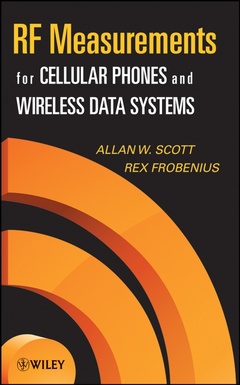Description
RF Measurements for Cellular Phones and Wireless Data Systems
IEEE Press Series
Authors: Scott Allen W., Frobenius Rex
Language: English
Keywords
cell phones; wireless systems; verizon; Motorola; nokia; ericsson; skyworks; mobile networks; mobile networking; radio frequency; mobile devices; mobile device manufacturing; mobile components; network components; GPS; wifi; 3g phones; pcs phones; RF measurments; RF test equipment; RF components
528 p. · 16.3x23.5 cm · Hardback
Description
/li>Contents
/li>Biography
/li>
It is predicted that by the year 2010, all digital wireless communications equipment?including cellular, PCS, and 3G phones; wireless LANs; GPS navigation systems; and DBS TV?will have data transfer capabilities of over 1 Mbps. Now, as this significant turning point quickly approaches, this book presents everything industry professionals need to know about the Radio Frequency (RF) measurements and tests that must be made on this new generation of digital wireless communications equipment.
Presenting just enough theory as is absolutely required for comprehension, RF Measurements for Cellular Phones and Wireless Data Systems:
Provides a review of basic RF principles and terminology
Describes RF measurement equipment, including signal generators, power meters, frequency meters, vector network analyzers, spectrum analyzers, and vector signal analyzers
Explains the RF devices that are used in cellular phones and wireless data transmission equipment?how they work, what their critical performance parameters are, how they're tested, and typical test results
Illustrates the testing of RF devices and systems with digitally modulated signals that represent the voice, video, or data that the RF wave is carrying
RF Measurements for Cellular Phones and Wireless Data Systems has been written to serve as the industry standard for RF measurements and testing. It is an indispensable resource for engineers, technicians, and managers involved in the construction, installation, or maintenance of cell phones and wireless data equipment.
Part I: RF and Wireless Principles.
2. Characteristics of RF Signals.
3. Mismatches.
4. Digital Modulation.
Part II: RF Measurement Equipment.
5. RF Signal Generators.
6. RF Power Meters.
7. Frequency Counters.
8. VNAs.
9. Spectrum Analyzers.
10. VSAs.
11. Noise Figure Meters.
12. Coaxial Cables and Connectors.
13. RF Measurement Uncertainties.
14. Components That Do Not Have Coaxial Connectors.
Part III: Measurement of Individual RF Components.
15. RF Communications System Block Diagram.
16. Signal Control Components.
17. PLOs.
18. Upconverters.
19. Power Amplifiers.
20. Antennas.
21. RF Receiver Requirements.
22. RF Filters.
23. LNAs.
24. Mixers.
25. Noise Figure Measurement.
26. Intermodulation Product Measurement.
27. Overall Receiver Performance.
28. RFICs.
Part IV: Testing of Devices with Digitally Modulated Signals.
29. Wireless Communication Systems.
30. Multiple Access Techniques: FDMA, TDMA, and CDMA.
31. OFDM, OFDMA, and WiMAX.
32. ACP.
33. Constellation, Vector, and Eye Diagram and EVM.
34. CCDF.
35. BER.
36. Measurement of GSM Evolution Components.
Terminology.
Index.
Rex Frobenius has been with Besser Associates for more than ten years, where he has been actively involved in course development for linear circuit design and test and measurement courses. He is also the author of several online utility software programs that are used to demonstrate fundamental RF principles.
These books may interest you

RF Circuit Design 178.87 €

Applications of Modern RF Photonics 173.00 €


